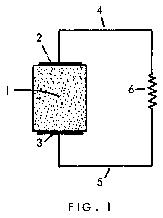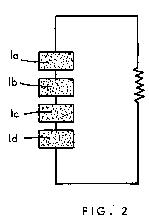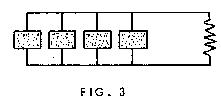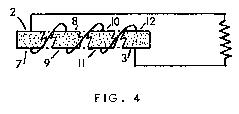"Electrical Source"
Preliminary Patent Application
(Return to Index Page)
August 19, 1976
Sunnyvale, California
Copyrighted © by The Townsend Brown family. All rights reserved.


 Background
Background:
Careful observations, conducted over a period of years, have revealed the existence at a "steady
state" electrical self-potential spontaneously developed by certain semiconductors. Exploratory
work with various semi-conducting material has revealed that massive high-K dielectrics, being
heavy semi-conducting materials with high dielectric constant, produce the greatest
self-potential . Solid dielectrics such as barium titanate, lead zirconate titanate and certain
natural rocks (granite, basalt, etc.) are found to produce this electrical self-potential. The
origin of the self-potential referred to in this application is believed to be not hitherto
known or identified. It is not piezoelectric, pyroelectric or electrochemical in origin.
Whereas, it appears to be a fact of nature that rocks and similar dielectric and semiconducting
materials spontaneously produce electricity, it is the purpose of this invention to apply the
means to extract that electricity so that it may be utilized. This application specifically
excludes piezoelectric (pressure related) and pyroelectric (heat related) effects commonly
observed in materials of this type and well known in the art. This application relates
exclusively to the phenomenon of "petroelectricity" (a new terminology) which is relatively
"steady state" and not dependent upon temperature, pressure or chemical action. The origin of
petroelectric energy is not presently known. It is obvious that this energy does not reside in
the material itself but must, it appears, have an external, perhaps even extraterrestrial
origin. Incident radiation from space (neutrino flux or opticaI -frequency gravitational
radiation has been proposed) but, at present, no adequate explanation exists.
The earmarks of the incoming radiant energy which appear to cause the petrovoltaic effect are
the clearly-evident diurnal cycles and occasional strong pulses of short duration. A research
program is presently underway to study the possibility that a new energy source (perhaps cosmic
in nature) may have been discovered.
This invention relates to the method of tapping the self-potential generated by such dielectric
or semi-conducting material. It relates to the placing upon, or attaching thereto, of electrodes
upon such material so as to conduct away and utilize the electrical potential developed therein.
It relates to the preparation of the dielectric surface so as to effectively receive said
electrodes. The invention further relates to the use of conductors or circuitry to convey said
electrical energy from said electrodes to the ultimate (end-use) of said electrical energy.
This invention, therefore, relates to the extraction and practical utilization of petroelectric
energy (so-called "rock electricity") by the application of suitable electrodes and circuitry to
semi-conducting materials.
The invention further relates to the inter-connecting of several mosses of semiconducting
materials so as to increase the total electrical output. It relates to systems of dielectric or
semi-conducting masses interconnected to produce large output of electrical energy.
 Specifications
Specifications:
Fig. 1 illustrates the simplest form of the invention. Massive (high density) semi-conducting
material 1, preferably of high specific inductive capacity (high-K) is adapted to receive
electrodes 2 and 3, the surfaces having been cleaned for good contact. Conductors 4 and 5
convey the potential difference present in material 1 to resistive load 6.

Fig. 2 illustrates a system of two or more masses 1a, 1b, 1c, 1d, etc. in series to provide
higher output voltage.

Fig. 3 illustrates a system, in parallel connection, to provide higher output current.

Fig. 4 illustrates the use of additional electrodes 7, 8, 9, 10, 11, 12, etc. for effective
electrical contact, interconnecting electrical domains of a semi-conducting material.

In the foregoing specification, it is to be understood that the use of semi-conducting masses,
wired and interconnected as shown, is fully covered in the present art of pieizoelectric and
pyroelectric sensors and electrochemical batteries and, therefore.. is not patentable. In such
cases, the energy converted into electricity is derived from kinetic energy, thermal energy or
battery-action, as the case may be. No external source of energy other than kinetic, thermal or
electrochemical is known to the art.
In the present application, the external source of energy is newly discovered and not, as yet,
fully identified or understood. The circuitry by which this newly-discovered energy is removed
from the receptor material and utilized is the some as that employed in piezoelectric,
pyroelectric or galvanic systems. Hence, it is necessary to distinguish between the systems in
the invention herein claimed.
 Claims
Claims:
I claim:
1 . Method for making available for utilization the electrical self-potential exhibited by
massive high-K dielectrics, other than that from piezoelectric, pyroelectric or electrochemical
action, consisting in attaching electrodes to said dielectrics, attaching conductors to said
electrodes and conveying the electrical potential to a useful load.
2. Method for removing and utilizing the electrical potential from petrologic materials, other
than that from piezoelectric or pyroelectric or galvanic sources, consisting in attaching
electrodes to said materials, connecting conductors to said electrodes and conveying said
electrical potential to a utilizing load.
3. Method for removing for purposes of utilization electrical energy from rock-like materials,
other than that from kinetic, thermal or electrochemical sources, consisting in attaching
conductors to said electrodes and conveying said electrical energy to a utilizing load.
4. Method of extracting electrical energy from massive high-K dielectrics, other than that
produced by mechanical strains, heat or electrochemical conversion, consisting in attaching
electrodes to said dielectrics, providing conductors from said electrodes thereby to convey the
extracted electrical energy for utilization in a load.
5. Method of utilizing petroelectric energy, other than that derived from piezoelectric,
pyroelectric or galvanic sources, consisting in attaching two or more electrodes to a rock,
applying conductors to said electrodes and removing the petroelectric energy to a useful load.
6. Method according to Claim 1, consisting of two or more dielectrics wired in series to provide
higher voltage.
7. Method according to Claim 1, consisting of two or more dielectrics wired in parallel to
provide higher current.
8. Method according to Claim 1, consisting of dielectrics formed from barium titanate, lead
zirconate titanate, lead monoxide -glycerine compound or other high-density high-K material.
9. Method according to Claim 3, consisting of rock-like materials such as granite, basalt and
metallic ores.
10. An electrical source, other than that provided by piezoelectric, pyroelectric and
electrochemical factors, comprising massive high-K dielectrics with electrodes attached thereto
and conducting output leads attached to said electrodes.
T. Townsend Brown
Sunnyvale, California
August 19, 1976


 Please be advised that this document is copyrighted © by The Townsend Brown family. All rights reserved.
Please see Legal and Copyright Information for additional copyright information.
Please be advised that this document is copyrighted © by The Townsend Brown family. All rights reserved.
Please see Legal and Copyright Information for additional copyright information.











